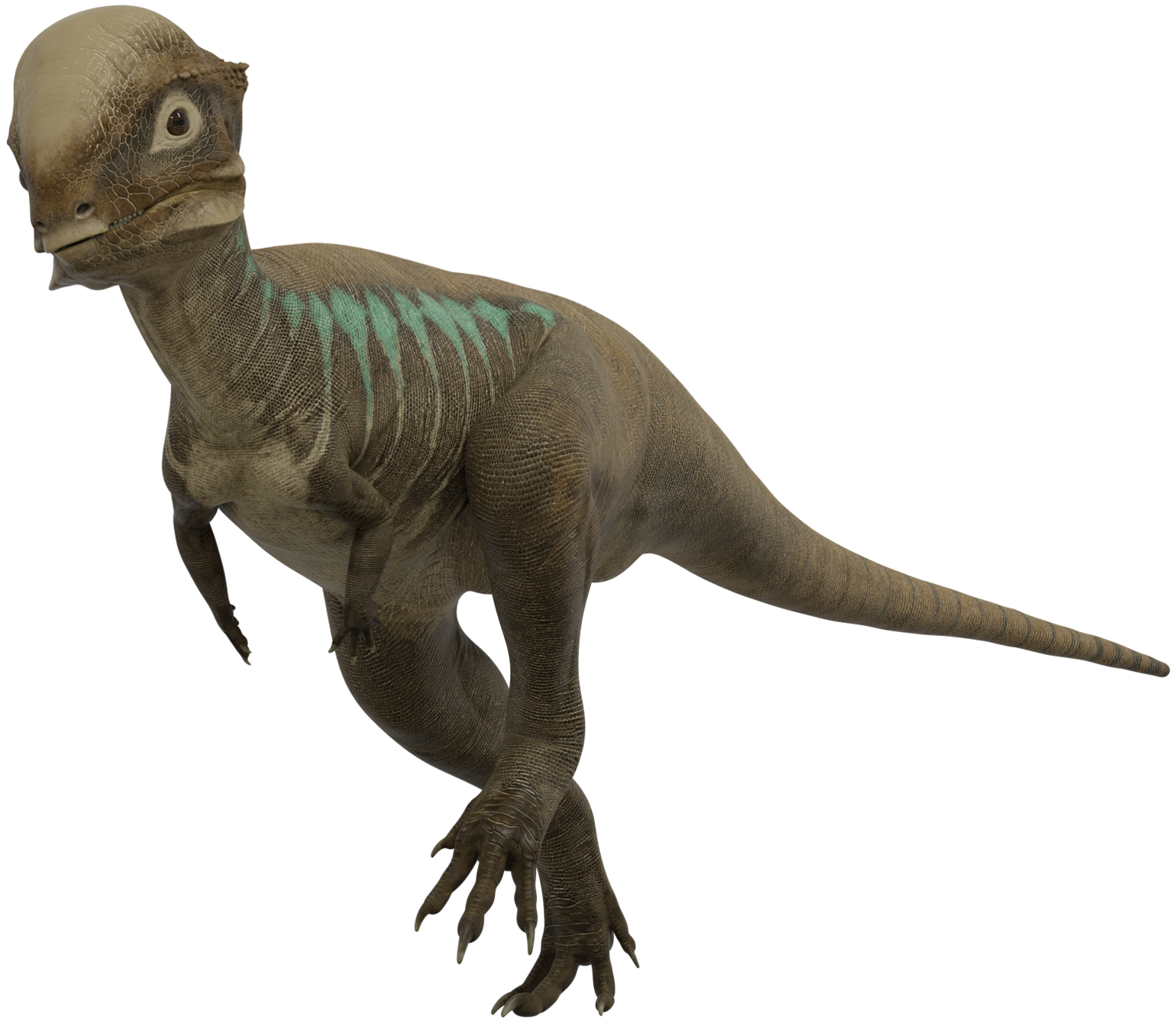The Little Battering Ram of Dinosaur Park
This small pachycephalosaur from Late Cretaceous Alberta had thick, dome shaped skulls which were probably used like battering rams during the breeding season, similar to modern mountain goats and big-horned sheep.
Overview: The Dinosaur Park and Oldman Formations are known for their large herbivores and carnivores, but they had small herbivores too. One of these was Stegoceras, a small pachycephalosaur, discovered at the turn of the 20th Century in Alberta. Their hyper-thickened dome shaped skulls were probably used like battering rams during the breeding season similar to modern mountain goats and big-horned sheep. Stegoceras was a forerunner of the larger, more advanced, and more famous Pachycephalosaurus.
Discovery: The first fossils of Stegoceras validum were discovered by Lawrence Lambe in rocks of the Late Cretaceous Oldman Formation of Alberta in 1898. In 1902 Lambe described and named them. Stegoceras is Greek, meaning “horn roof”, and validum is Latin for “strong”, named in reference to the thick domed skull roof. When Stegoceras was first discovered it was clear what exactly it was, but as additional specimens were discovered in the Oldman and Dinosaur Park Formation, the picture became clearer, though Stegoceras was still sometimes used as “wastebasket taxon” for small-medium sized pachycehalosaurs from North America. In the 21st Century, significant work to more clearly define Stegoceras resulted in some animals called Stegoceras being renamed, and other animals considered distinct becoming synonymized with Stegoceras. Some examples of the latter were Ornatotholus, found to be a juvenile Stegoceras, Hanssuesia, and Gravitholus, which was found to be the final growth stage of Stegoceras. In 2011, a second species of Stegoceras, S. novomexicanum, was named from New Mexico. However, this may in fact be a juvenile S. validum (which would extend its range far to the south), a juvenile Sphaerotholus, or perhaps a unique genus of its own.
Evolution: Stegoceras was a pachycephalosaur, a dome-headed, bipedal, herbivore related to Pachycephalosaurus. Pachycephalosaurs were members of the clade Marginocephalia, which also includes ceratopsians, making Stegoceras a distant cousin of the likes of Chasmosaurus and Centrosaurus with which it shared its habitat. Among known pachycephalosaurs, Stegoceras, which appeared about 77.5 million years ago, is considered basal (“primitive”), however, the fact that the last common ancestor of pachycephalosaurs and ceratopsians would have lived in the Late Jurassic indicates that there is ghost lineage of more basal pachycehalosaurs going all the way back to the Jurassic which paleontologists just haven’t discovered yet.
Description, Behavior, and Ecology: Stegoceras was a small to medium sized pachycephalosaur, measuring about 2 to 2.5 meters (6.6 to 8.2 ft) long and weighing 10-40 kg (22-88 lbs). Like other pachycephalosaurs it had a dome-shaped, hyper-thickened skull roof and a short, triangular snout which would have had a small blunt beak. Around the dome was fringed by the squamosal bones which formed a sort of shelf or small frill at the back of the skull which was covered in small bumps, knobs, and spikes. The teeth of Stegoceras were small, serrated and leaf shaped, with a high degree of variability (heterodonty). They are actually similar to the teeth of the theropod Troodon, and at one point in time, Stegoceras was briefly classified as Troodon despite not being closely related at all. Stegoceras was an herbivore that used these teeth to slice through soft plant matter, like leaves and fruit. Similarly, while troodontids are typically thought to be carnivores, Troodon seems to have been an omnivore, hence its teeth are convergent with Stegoceras. Stegoceras may have also occasionally eaten insects, technically making them potential omnivores as well.
Stegoceras lived in the shadow of larger herbivores like the ceratopsids Chasmosaurus and Centrosaurus, the duckbilled hadrosaurs Brachylophosaurus, Prosaurolophus, Lambeosaurus, Gryposaurus, Corythosaurus, and Parasaurolophus, and the ankylosaurs Edmontonia and Euoplocephalus. The top predators of its environment were the tyrannosaurs Gorgosaurus and Daspletosaurus. While adult tyrannosaurus may have been a threat to Stegoceras, they may have been too small and fast for the tyrannosaurus to consider a regular food source. However, juvenile tyrannosaurs were probably fast and nimble enough to hunt them. Stegoceras may have also been prime prey for dromaeosaurs like Saurornitholestes and Dromaeosaurus, and juvenile Stegoceras may have been hunted by the likes of Troodon.
Stegoceras likely dealt with predators by running away, but a Stegoceras guarding its nest or offspring may have used its head as a battering ram against some of these predators. However, their dome skulls were probably most often used on each other. Stegoceras may have had a social structure similar to modern big horned sheep, where males head-butt each other in battles for dominance and over access to females during the breeding season. Juveniles had smaller flatter domes which grew thicker and more domed as they reached adulthood. Skull thickness and thickness of the nasal boss (a thickening of bones on the nose) may have also varied between males and females with the more combative males having the more robust skulls.
Extinction and Legacy: Stegoceras disappeared around 75 million years ago for unknown reasons. It is possible that it was simply replaced by other forms of pachycephalosaurs, which continued on until the end of the Cretaceous period. Today, Stegoceras can be found in museums such as the Canadian Museum of Nature in Ottawa, Ontario, Canada, the Royal Tyrrell Museum in Drumheller, Alberta, Canada, and the National Museum of Natural History (Smithsonian) in Washington D.C., USA.
Stegoceras FAQ
Stegoceras size / How big was an Stegoceras?
See height, weight, and length.
Stegoceras height / How tall was Stegoceras?
Stegoceras was probably about 0.88 meters (2.89 ft) tall.
Stegoceras weight / How much did Stegoceras weigh?
Stegoceras weighed about 10-40 kg (22-88 lb).
How long was Stegoceras?
Stegoceras was about 2 to 2.5 meters (6.6 to 8.2 ft) long!
What did Stegoceras eat?
Stegoceras ate soft plants, perhaps including fruit, as well as possibly insects, making it a potential omnivore, though it was mostly herbivorous.
What is Stegoceras closest living relative?
Like all dinosaurs, the closest relatives of Stegoceras are the only surviving lineage of dinosaurs today, the birds. Crocodilians, while not dinosaurs themselves, are also more distant cousins of dinosaurs.
Stegoceras family members / Stegoceras family / What kind of dinosaur was Stegoceras?
Stegoceras was an ornithischian (“bird-hipped dinosaur”) in the family Pachycephalosauridae making it a close relative of the larger and later Pachycephalosaurus. Pachycephalosauridae belonged to the larger clade Pachycephalosauria (dome-headed dinosaurs), which in turn belonged to Marginocephalia which also contains the Ceratopsia.
Where did Stegoceras live? / Where was Stegoceras found?
Stegoceras lived in Laramidia (western North America) and has been found in Alberta and Montana.
When did Stegoceras live?
Stegoceras lived about 77.5-75 million years ago in the Late Cretaceous Period.
What does Stegoceras mean? / Stegoceras name meaning
Stegoceras means “Horn Roof”.
Did Stegoceras butt heads?
Yes, pathologies on fossils of pachycephalosaur domes suggests that they did indeed headbutt each other.

